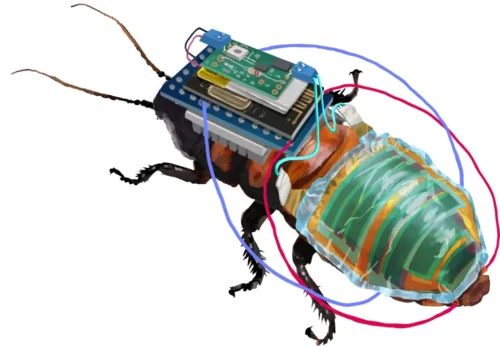Researchers have created remote-controlled cyborg cockroaches, equipped with a tiny wireless control module and a rechargeable battery attached to a solar cell.
Researchers have been trying to design cyborg insects to help inspect hazardous areas and monitor the environment. For the use of cyborg insects to be practical, handlers must be able to control them remotely for long stretches of time. This entails wireless control of their leg segments, powered by a tiny rechargeable battery.

Battery is a very important feature which was added to the project as nobody wants a suddenly out-of-control swarm of cyborg cockroaches roaming around. The docking system concept was not adapted as it would consume time in returning from its location and could compromise the time sensitive missions. Therefore, an optimum approach is to include an onboard solar cell that can continuously ensure that the battery stays charged.
To successfully integrate these devices into a cockroach the engineering team developed a special backpack and ultrathin organic solar cell modules with an adhesion system that keeps the machinery attached for long periods of time while still allowing natural movements.
The ultrathin 0.004 mm thick organic solar cell module was mounted on the back side of the abdomen. “The body-mounted ultrathin organic solar cell module achieves a power output of 17.2 mW, which is more than 50 times larger than the power output of current state-of-the-art energy harvesting devices on living insects,” said Kenjiro Fukuda, RIKEN Cluster for Pioneering Research (CPR).
After carefully examining natural cockroach movements, the scientists realized that the abdomen changes shape and portions of the exoskeleton overlap. To accommodate this, they interleaved adhesive and non-adhesive sections onto the films, which allowed them to bend but also stay attached. When thicker solar cell films were tested, or when the films were uniformly attached, the cockroaches took twice as long to run the same distance.
“Considering the deformation of the thorax and abdomen during basic locomotion, a hybrid electronic system of rigid and flexible elements in the thorax and ultrasoft devices in the abdomen appears to be an effective design for cyborg cockroaches,” says Fukuda. “Moreover, since abdominal deformation is not unique to cockroaches, our strategy can be adapted to other insects like beetles, or perhaps even flying insects like cicadas in the future.”





